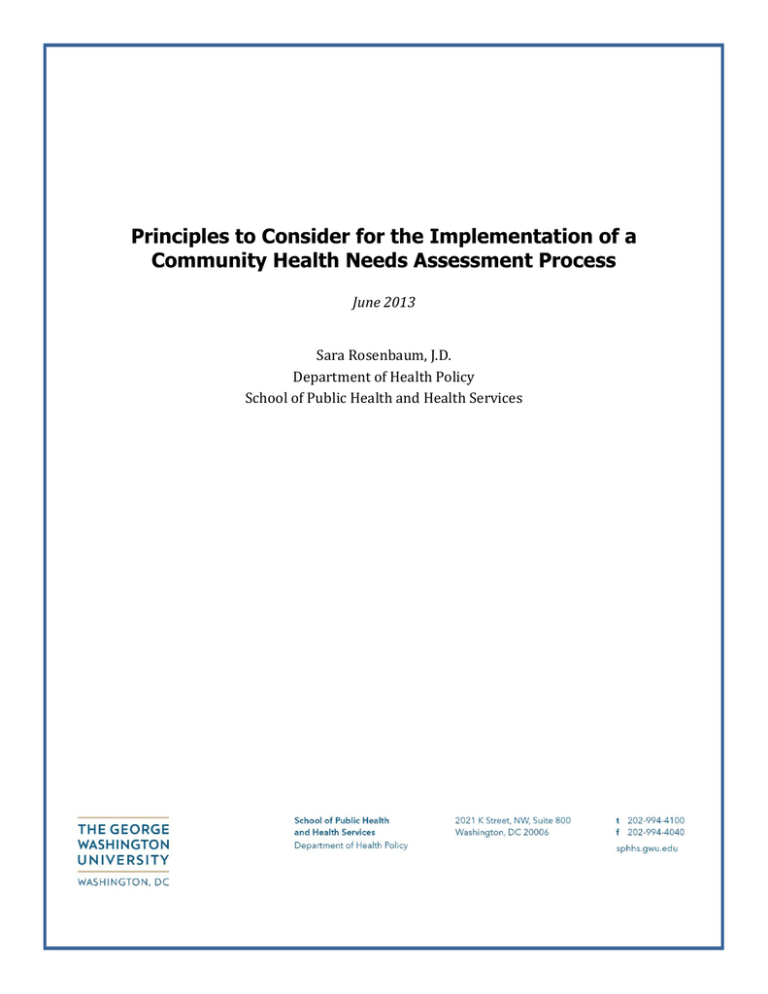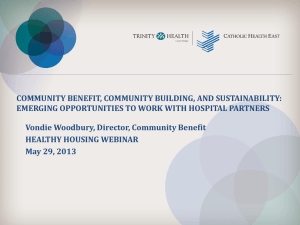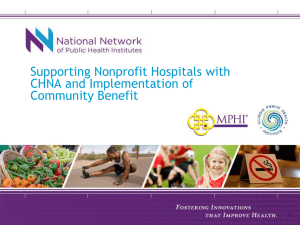Principles to Consider for the Implementation of a Sara Rosenbaum, J.D.
advertisement

Principles to Consider for the Implementation of a Community Health Needs Assessment Process June 2013 Sara Rosenbaum, J.D. Department of Health Policy School of Public Health and Health Services Introduction This document identifies guiding principles to inform the implementation of the Affordable Care Act’s community health needs assessment provisions applicable to not-for-profit hospitals that seek federal tax-exempt status. These principles offer a pathway for hospitals, public health entities and other interested parties to work collaboratively to address the health needs of their communities. The community health needs assessment provision of the Affordable Care Act (Section 9007) links hospitals’ tax-exempt status to the development of a triennial needs assessment and implementation strategy. A collaborative communitywide approach to community health needs assessment can increase the likelihood of well-targeted initiatives that address the needs of communities and improve the health of their residents. Based on evidence from the public health literature, this document focuses on conducting evidence-based needs assessment and prioritization, making evidence-based community health investments, evaluating and measuring progress, and improving quality, transparency and community engagement. In addition to considering these principles, those interested in successfully implementing the community health needs assessment provisions will benefit from assessment and planning, community health and related data, and awareness of evidence-based interventions. Overview Improving the health of communities is a core public health activity. In Primary Care and Public Health, which examines the opportunities for collaboration between public health and primary care, the Institute of Medicine (IOM) has written [e]nsuring that members of society are healthy and reaching their full potential requires the prevention of disease and injury; the promotion of health and well-being; the assurance of conditions in which people can be healthy; and the provision of timely, effective, coordinated health care.1 According to the IOM, achieving these goals requires evidence-based interventions across three principal domains: 1. The social, economic and environmental conditions that act as the primary determinants of individual and population health. 2. Health care services for individuals. 3. Public health activities that target populations and address individual health behaviors, such as smoking and excessive alcohol consumption.2 1 2 Institute of Medicine, Primary Care and Public Health (Washington D.C., 2012) [pre-publication copy], p. S-1 Id., p. 4. 1 Principles to Consider for the Implementation of a Community Health Needs Assessment Process The effectiveness of these interventions in turn rests on three fundamental tenets: 1. A process for planning to improve community health. 2. Prioritizing and investing in evidence-based interventions, while allowing for innovative interventions that can improve health. 3. Evaluating the results of investments and incorporating these results into an ongoing cycle of evidence-based assessment and improvement. At each stage of community health improvement, inclusiveness and transparency are key to generating a maximum level of community engagement. Improving Community Health is an Important Component of the Affordable Care Act The Affordable Care Act contains numerous provisions aimed at improving community health through direct investments in wellness and prevention at the individual and community levels and by making population health improvement an integral part of efforts to improve the quality and efficiency of health care. The health care law’s commitment to community health improvement can be seen in initiatives such as Coverage of certain evidence-based clinical preventive health services—including immunizations and recommended cancer screenings—without cost sharing for all Americans in new health plans and those covered by Medicare. The Prevention and Public Health Fund which makes investments in programs, services, and activities that improve community health. Community Transformation Grants, which support communitywide efforts to reduce the burden of chronic disease. The Center for Medicare and Medicaid Innovation, which tests new approaches for improving patient health outcomes, reducing cost, and improving population health. Accountable care organizations that take responsibility for the total costs and quality of care received by their patients.3 The Community Health Center Trust Fund,4 which aims to extend the capacity and reach of the nation’s community health centers. Investments in new approaches to integrating primary care and public health through medical homes.5 Direct investments in prevention strategies and the development of clinical prevention capacity. The development and implementation of a National Prevention Strategy, which emphasizes prevention and wellness as important elements of health system improvement.6 3 Section 1899 of the Social Security Act PPACA § 10503. 5 PPACA § 4001. 6 http://www.healthcare.gov/prevention/nphpphc/strategy/report.pdf (Accessed March 17, 2012). 4 2 Principles to Consider for the Implementation of a Community Health Needs Assessment Process Development and implementation of a National Quality Strategy,7 which focuses on improving health care quality, including through evidence-based interventions to improve population health. The Affordable Care Act also strengthens the community health improvement activities of the nation’s more than 2,900 nonprofit hospitals8 by adding a community health needs assessment as a condition of their federal tax-exempt status. Tax-exempt hospital organizations will conduct a community health needs assessment at least once every three years, which will be made widely available to the public. They also will adopt an implementation strategy to meet the community health needs identified through the assessment. On April 3, 2013, the Department of the Treasury and Internal Revenue Service (IRS)9 issued a proposed rule regarding Community Health Needs Assessments for Charitable Hospitals (CHNA). The proposed rule reiterates that in assessing the community’s health needs, a hospital facility must take into account input from people who represent the broad interests of its community, including those with special knowledge of or expertise in public health. Hospital organizations may continue to rely on the guidance provided in the CHNA Proposed Rule for community health needs assessments conducted and implementation strategies adopted up to 6 months after final or temporary regulations relating to the community health needs assessment requirements are published.10 Principles to Inform Implementation of the Affordable Care Act’s Community Health Needs Assessment Provisions The public health literature points to a series of basic principles for approaching efforts to improve community health and shows that they can apply in many different settings. 1. Multisector collaborations that support shared ownership of all phases of community health improvement, including assessment, planning, investment, implementation, and evaluation. The literature suggests that community health improvement efforts are most successful when they are grounded in “collective impact,” where “highly structured collaborative efforts” yield “substantial impact on a large scale social problem.”11 Collective impact focuses on cooperation, collaboration, and partnership to help achieve common priorities and inform partners’ investment strategies.12 Steps to support collective impact include 7 http://www.hhs.gov/news/press/2011pres/03/20110321a.html (Accessed March 18, 2012). Health Forum LLC. “Fast Facts on US Hospitals.” American Hospital Association. 03 Jan 2013. Web. 1 Mar 2013. http://www.aha.org/research/rc/stat-studies/fast-facts.shtml. 9 78 Fed. Reg. 20523 (proposed April 5, 2013) (to be codified at 26 C.F.R pts. 1, 53). 10 Id. at 20543 (to be codified at 26 CFR § 1.501(r)-7). 8 3 Principles to Consider for the Implementation of a Community Health Needs Assessment Process 1. A shared commitment to improving health that reflects a common understanding of the problem and a joint approach to solutions and actions. 2. Shared measurement to assure consistent data and results across participants’ activities. 3. A mutually reinforcing plan of action that supports participants pursuing different activities that are consistent with their strengths and capacity. 4. Continuous communication that is consistent and open across the many players in order to “build trust, assure mutual objectives, and create common motivation.” 5. “Backbone” support through an organization with the capabilities to coordinate agencies and participants. Depending on the community, the partners may vary, and the “backbone” may differ. In some communities, hospitals might lead the planning effort. In others, one or more public health agencies might lead the effort. Yet another model might entail creating or empowering an entity that comprises and supports multiple participants. In the CHNA Proposed Rule, the Treasury and IRS emphasize the planning options available to hospitals, including the option to engage in broader, multisector planning activities with other organizations, while complying with appropriate reporting requirements.13 2. Proactive, broad, and diverse community engagement to improve results. In Principles of Community Engagement, the United States Department of Health and Human Services presents evidence of successful efforts to improve community health for such public health priorities as smoking cessation, obesity, cancer, and heart disease. Those efforts involve identifying and creating interventions designed to give all community actors a shared sense of ownership in the activity.14 For example, a coalition of community actors to support community health improvement could include Community hospitals, including nonprofit hospitals and hospital systems that engage in community health improvement planning. State and local public health agencies with expertise in measuring population health; in applying the methods and processes of community health planning and community engagement; and in formulating, implementing, and evaluating of evidence-based interventions that are responsive to health priorities. Voluntary, civic, and faith-based organizations, among others, engaged in community service and community health improvement. Health consumers and the organizations and entities that represent consumers from across the community. Community businesses and employers. 13 Id. at 20541-20542 (to be codified at 26 CFR §§ 1.501(r)-3(b)(7)(iv)-(v), 1.501(r)-3(c)(4)). United States Department of Health and Human Services, Principles of Community Engagement (2d Ed.) (NIH Pub. No., 11-7782, June, 2011). 14 4 Principles to Consider for the Implementation of a Community Health Needs Assessment Process Community-based health care providers. State health care agencies and public insurers such as Medicaid and CHIP programs. Private health insurers and administrators of employee health benefit plans and health and wellness programs. Education and social services agencies and organizations whose activities affect the health of their communities. Successful models indicate that community engagement is essential at each stage of the community health improvement process including planning, needs assessment, identifying priorities, and gathering evidence on possible interventions, investment, and evaluation. The CHNA Proposed Rule emphasizes involvement by people who represent the “broad interests” of the communities served by nonprofit hospitals, including people with “special knowledge of or expertise in public health.”15 3. A hospital’s definition of community that encompasses both a significant enough area to allow for population-wide interventions and measurable results, and includes a targeted focus to address disparities among subpopulations. Community health improvement research emphasizes defining community broad enough to create measurable opportunities to address the health of a population as a whole while also specific enough to focus on the health of subpopulations who face elevated health risks. The Treasury and IRS proposed rule take a similar approach. “In defining the community…a hospital facility may take into account all of the relevant facts and circumstances, including the geographic area served by the hospital facility, target populations served (for example, children, women, or the aged), and principal functions (for example, focus on a particular specialty area or targeted disease).”16 Communitywide planning includes at-risk populations served by the hospital. A hospital facility’s community may not be defined in a manner that excludes “medically underserved, low income, or minority populations who are part of its patient populations, live in the geographic areas in which its patient populations reside (unless they are not part of the hospital facility’s target populations or affected by its principal functions), or otherwise should be included based on the method the hospital facility uses to define its community.”17 This is consistent with IRS Form 990, an annual reporting return that certain federally taxexempt organizations must file with the IRS. It provides information on the filing organization’s mission, programs, and finances. Form 990 asks hospitals to describe the community the organization serves, taking into account the geographic area and demographic constituents it serves. 15 78 Fed. Reg. at 20541 (to be codified at 26 CFR § 1.501(r)-3(b)(5)). Id. at 20540-20541 (to be codified at 26 CFR § 1.501(r)-3(b)(3)).. 17 Id. 16 5 Principles to Consider for the Implementation of a Community Health Needs Assessment Process 4. Maximum transparency to improve community engagement and accountability. Transparency helps foster better input and decision making, more accountability, and shared responsibility for outcomes. Greater transparency in identifying and investing in community health needs fosters community trust and understanding. Transparency promotes accountability by making public the identified needs, the evidence base, and the choice of investment priorities and the results. Broad awareness encourages all involved to make the choices that will be most likely to be successful. Transparency also makes it possible to link investments to subsequent evaluations of their effectiveness in improving community health. The CHNA Proposed Rule requires that the community health needs assessment report— which identifies community health needs—be made widely available to the public. That is, the report itself or a link to the report must be “conspicuously” posted on the hospital organization or facility’s website so the public can download and review it.18 Moreover, the CHNA Proposed Rule requires a hospital organization to attach to its annual Form 990 either a copy of the most recently adopted implementation strategy for each of its hospital facilities, or the URL of each Web page on which it has made each recently adopted implementation strategy (along with the community health needs assessment report) widely available to the public.19 Hospital 990 forms and attachments are available to the public. Public access to implementation strategies enhances transparency of the assessment process and permits communities to see how chosen interventions address identified health needs. 5. Use of evidence-based interventions and encouragement of innovative practices with thorough evaluation. Using evidence-based interventions—those that have been implemented, evaluated, and proven to yield results—provides the greatest likelihood that community health needs assessment-driven investments will improve community health. In addition, innovative promising practices can be coupled with thorough evaluation to help improve health and further build the evidence base for community interventions. Under Treasury and IRS policies, hospital investments in community health improvement—as well as in health care—are recognized as a community benefit.20 Community health improvement efforts can involve investments in primary and preventive clinical care in community settings. Furthermore, IRS guidance clarifies that the Treasury and IRS will recognize hospital investments in certain community building activities as 18 Id. at 20539 (to be codified at 26 CFR § 1.501(r)-1(c)(4)). The hospital facility must also make a paper copy of the community health needs assessment report available for public inspection without charge at the hospital facility. Id. at 20542 (to be codified at 26 CFR § 1.501(r)-3(b)(8)). 19 Id. at 20543 (to be codified at 26 CFR § 1.6033-2(a)(2)(ii)(I)(2)). 20 Schedule H worksheet to accompany Form 990 (2011), www.irs.gov. 6 Principles to Consider for the Implementation of a Community Health Needs Assessment Process community health improvement investments.21 The Community Preventive Services Task Force has identified community building activities that are evidence-based community health improvement practices (e.g., increasing access to places for physical activity).22 6. Evaluation to inform a continuous improvement process. Continuous evaluation and improvement is fundamental for efforts to improve community health and for quality public health practice.23 The community health needs assessment process is ongoing and includes implementation strategies that set forth hospitals’ investments in improving the health of their communities. Hospitals must update their community health needs assessment reports every three years, and submit their implementation strategies to IRS in their Form 990 submissions or post them online. Implementation strategies must include a description of the anticipated impact of the actions the hospital facility intends to take to address the health need, including a plan to evaluate such impact.24 Moreover, in their annual Form 990 submissions, hospitals must describe what actions were taken to execute their implementation strategies during the taxable year, or if no actions where taken with respect to a significant health need, provide reasons why no actions were taken.25 In addition, hospitals must consider written comments received from the public on their most recently conducted community health needs assessments and most recently adopted implementation strategies.26 As implementation proceeds in the years between assessments, evaluation can inform implementation. 7. Use of the highest quality data pooled from, and shared among, diverse public and private sources. Effective community health improvement planning is bolstered by a solid base of evidence related to community and population health, the availability and performance of community health interventions, and evidence regarding innovative investments that improve health and system performance.27 Building a strong evidence base involves sharing data from multiple sources and from both public and private contributors, as well as ensuring that appropriate privacy and security safeguards are taken. This principle of shared data for community health improvement can be seen in the CHNA Proposed Rule which allows for a communitywide focus on planning and investments that benefit the health of communities as a whole.28 21 Internal Revenue Service. (2012). Instructions for Schedule H (Form 990). Retrieved from http://www.irs.gov/pub/irs-pdf/i990sh.pdf. 22 Centers for Disease Control and Prevention. The Guide to Community Preventive Services. 14 Feb. 2013. Accessed 12 Mar. 2013 http://www.thecommunityguide.org/index.html. 24 78 Fed. Reg. at 20542 (to be codified at 26 CFR § 1.501(r)-3(c)(2). Id. at 20543 (to be codified at 26 CFR § 1.6033-2(a)(2)(ii)(I)(3)). 26 Id. at 20541 (to be codified at 26 CFR § 1.501(r)-3(b)(5)(iii)). 27 CDC, The Guide to Community Preventive Services. 28 78 Fed. Reg. at 20541-20542 (to be codified at 26 CFR §§ 1.501(r)-3(b)(7)(iv)-(v), 1.501(r)-3(c)(4)). 25 7 Principles to Consider for the Implementation of a Community Health Needs Assessment Process Conclusion The collaborative, transparent approach to community health needs assessment can accelerate assessment, planning, intervention, and evaluation in order to achieve enhanced community health improvement. These principles can help guide implementation of the Affordable Care Act’s community health needs assessment provisions by offering a straight-forward, feasible approach that hospitals and communities can use to pursue their mutual goal of community health improvement. 8







